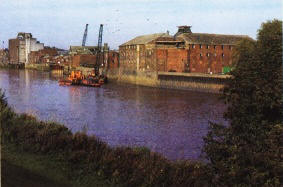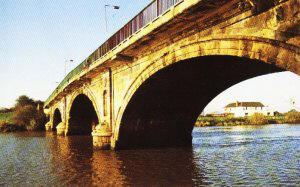BRITAIN'S MOST INLAND PORT The Trent has always been the life and soul of Gainsborough, Britain's most inland port; indeed, it was the river which brought the first settlers to this place. The tribe of Angles called the Gainas The daughter of Ethelred, the Gainas tribal chief, married Alfred the Great in 868, and Alfred fought long and hard to keep the invading Danes out of Gainsborough. But by 1013 the town was under the control of the Vikings led by Sweyn Forkbeard, who sought revenge for the deaths of his sister, her husband and her son. Sweyn's son Canute was crowned in 1014, and there are those in the town who maintain that his attempt to order the tide to obey him was made in the Trent at Gainsborough; the natives of Canvey Island in Essex make a similar claim, however! Gainsborough soon became prominent as a port and was named in 1322 as one of the ports used for supplying corn to the king. As Torksey, at the junction of the Foss Dyke and the Trent, fell into decay, so Gainsborough's importance grew throughout the fifteenth century and beyond. In 1643 Gainsborough found itself at the heart of the conflict between Parliamentarians and Royalists, the Earl of Kingston was holding the town for the king but was surprised by Lord In the seventeenth and eighteenth centuries the industrialised midlands imported and exported extensively through Gainsborough, and a second Tuesday market was inaugurated to supplement the market already held on Saturdays. A new canal linking the Trent to other rivers increased trade still further, and soon Gainsborough's riverside was lined with warehouses and wharves to cope with the traffic. The building of a new bridge across the river in 1790 allowed Gainsborough to expand along both banks, but the dawn of the railway age and new rail links to Grimsby and Hull spelled the end of the town's most prosperous era, as it did for so many others
|
 sailed up the Trent soon after the Romans had left the area. Protected by the river to the west, by marshy ground to the north and south and by easily guarded high land to the east, the site was an ideal one for a new settlement, even though the Romans had always
sailed up the Trent soon after the Romans had left the area. Protected by the river to the west, by marshy ground to the north and south and by easily guarded high land to the east, the site was an ideal one for a new settlement, even though the Romans had always Willoughby of Parham, and while the earl was being taken along the river as a prisoner he was killed by a cannon shot from his own Royalist troops who did not realise that their leader was aboard When the Royalists later tried to retake the town they were routed by Cromwell at Lea, and the Royalist leader Charles Cavendish was killed in the swampy ground to the south of Gainsborough.
Willoughby of Parham, and while the earl was being taken along the river as a prisoner he was killed by a cannon shot from his own Royalist troops who did not realise that their leader was aboard When the Royalists later tried to retake the town they were routed by Cromwell at Lea, and the Royalist leader Charles Cavendish was killed in the swampy ground to the south of Gainsborough.